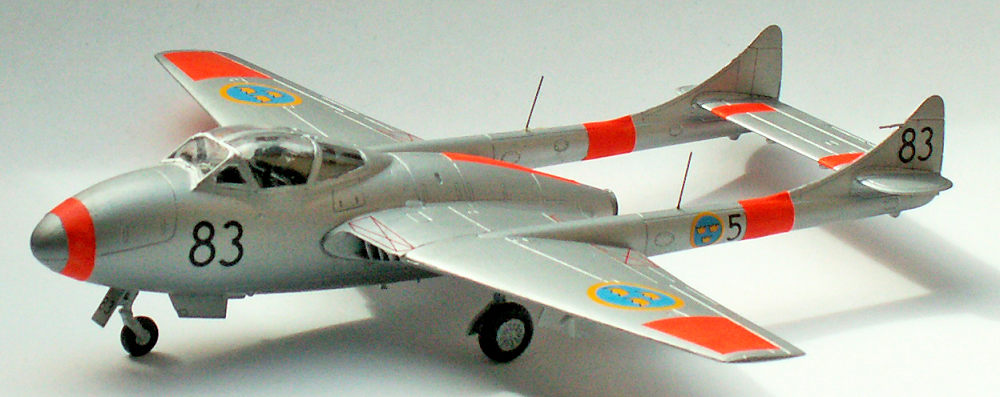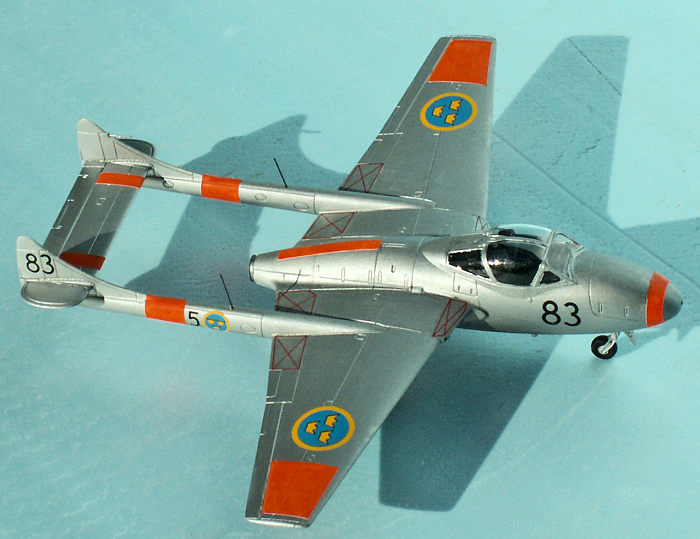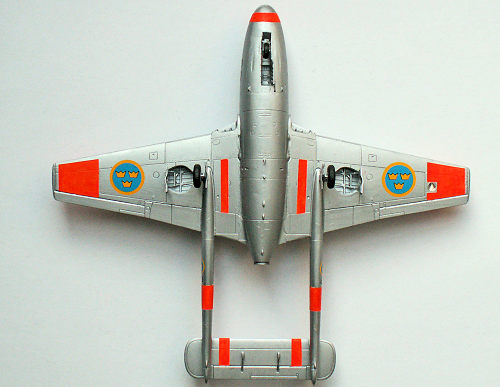
Airfix 1/72 De Havilland Vampire T 11
| KIT #: | A55204 |
| PRICE: | $15.00 |
| DECALS: | One option |
| REVIEWER: | Torben Plesberg |
| NOTES: | Starter set with paints. |

| HISTORY |
The Vampire is one of the really old jet fighters. The prototype made its first flight 9-20-1943, only six months after the first flight of Britain’s first jet fighter, the Gloster Meteor. The German Messerschmitt Me 262 took to the air on jet power alone for the first time 7-18-1942. The American Bell P-59 Airacomet flew for the first time 10-2-1942 in California. This plane was, however, no success as a fighter plane. The first successful American jet fighter, the Lockheed P-80 Shooting Star, flew for the first time 6-11-1944. This plane came too late to see service during WWII. Post war, it became a success, and the trainer version T-33 A became legendary.
 The twin
boom configuration of the Vampire had the advantage of a minimum of loss of
power in the jet pipe, because it was short. This was of particular importance
because of the modest power output of the early Goblin engines. Conventional
single engine jets with the engine built into the fuselage were born with long
jet pipes and a corresponding loss of power.
The twin
boom configuration of the Vampire had the advantage of a minimum of loss of
power in the jet pipe, because it was short. This was of particular importance
because of the modest power output of the early Goblin engines. Conventional
single engine jets with the engine built into the fuselage were born with long
jet pipes and a corresponding loss of power.
The Vampire was ordered for the RAF, and of course also the Gloster Meteor. However, the first production Vampires did not fly until April 1945, and the type never saw action during the war, opposite the Gloster Meteor. The Vampire went into RAF service as a fighter bomber in large numbers, and was the first aircraft to exceed 500 mph.
De Havilland developed a two seat (side by side) Vampire configured as a night fighter and with a large radar in the nose cone. This project got the green light from the RAF, too, and the Vampire night fighter entered service with three squadrons. The two seat Vampire became a most efficient trainer aircraft with dual controls and the radar removed. This variant was called DH 115 Vampire T 11 and became a great success. The Vampire was also developed as a carrier born fighter: the Sea Vampire. Total production of all Vampires amounted to 3268 aircraft. The type was in service with no less than 31 air forces world- wide. Even to-day, Vampires are flying at air shows, being a popular war bird.
In Sweden, the
Vampire got the designation J-28. The A and B were fighter bombers. The A was
the early version FB 1, and the B was a late version: the FB 5. The J-28 C was
the T 11, which in fact had the designation T 55 being an export version. The C1
had the early type of framed canopy hood, the C2 had the late blown hood with a
better view. A number of J-28 B were allocated to the F 5 for advanced training.
One should have expected that The designation of the Vampire T 11 trainer would
be SK-28 C, however, for som e
reason the aircraft never got this designation officially, according to author
Jan Jørgensen in his book “Nordic Airpower 2 - Flygvapnet. Björn Karlström uses
the designation SK-28 C in his book “Flygplansritningar 1”.
e
reason the aircraft never got this designation officially, according to author
Jan Jørgensen in his book “Nordic Airpower 2 - Flygvapnet. Björn Karlström uses
the designation SK-28 C in his book “Flygplansritningar 1”.
The Vamps did a good job in service in the gap between the piston engine fighters and the Swedish built J-29 Tunnan and J-32 Lansen. The fighter bombers were retired in 1956, replaced by J-29 Tunnan and J-34 Hawker Hunter, which also was a stop gab fighter aircraft. The J-28 C was retired ten years later, when the SAAB SK-60 became available.
At an air show in Malmö 1962, I saw the J-28 C2 for the first time. A single aircraft from the F 5 wing, Krigsflygskolan, gave an impressive demonstration of aerobatics, as the speaker said: “Et Sk-28 skolflygplan från F 5 avancerer.” I took some photos of the Vampire, the 83, and it is the subject of my model.
| THE KIT |
The Airfix
Vampire T 11 Starter set comes in a nice red box with six potlets of Aqua paint,
a small tube of plastic glue, and two brushes attached. On the lid, there is a
picture of a Vampire of the RNZAF, and on the underside, there is a nice
drawing, showing how to paint, and decal the model. Instructions is a foldout s heet
in size A4. Page one is a short history of the Vampire in five languages,
including Swedish. Page two gives assembly instructions in no less than twelve
languages. Page three gives some safety information, also in twelve languages,
however, Greek is replaced by Norwegian – for some reason or another. Pages four
and five show in 17 steps how to assemble the kit, and with HB references for
colors of the details. Page six is for your personal notes.
heet
in size A4. Page one is a short history of the Vampire in five languages,
including Swedish. Page two gives assembly instructions in no less than twelve
languages. Page three gives some safety information, also in twelve languages,
however, Greek is replaced by Norwegian – for some reason or another. Pages four
and five show in 17 steps how to assemble the kit, and with HB references for
colors of the details. Page six is for your personal notes.
There are three sprues in a light grey styrene and a clear one for the canopy. All parts fit perfectly together – it is an easy built kit. The paints with the kit are as follows: HB 11 silver, HB 24 trainer yellow, HB 33 black, HB 53 gun metal, HB 56 aluminium and HB 86 light olive. Paint numbers: 11, 53 and 56 are metallic colors, the others are matt colors. If you choose to make the option of the kit, these colors will do the job. The two brushes are both round ones. For the large areas, however, a broad brush will do a better and quicker job. I would prefer a broader brush with the kit in place of the larger of the two round brushes. The decal sheet looks perfect with the option of a Vampire of the RNZAF, squadron 14. However, I used an alternative decal sheet for my model.
| CONSTRUCTION |
 If you
follow the instructions, step by step, you will end up with a very nice and
correct mini replica of a Vampire T 11. The construction phase was a pure
pleasure, no annoying items at all. This kit is a true winner and may serve as
an example of how a top kit should be. The interior of the cockpit should be
painted flat black before the assembly of the fuselage halves. Don’t forget lead
in the nose, minimum 7 gram.
If you
follow the instructions, step by step, you will end up with a very nice and
correct mini replica of a Vampire T 11. The construction phase was a pure
pleasure, no annoying items at all. This kit is a true winner and may serve as
an example of how a top kit should be. The interior of the cockpit should be
painted flat black before the assembly of the fuselage halves. Don’t forget lead
in the nose, minimum 7 gram.
| COLORS & MARKINGS |
 The color
scheme of a Swedish J-28 C is aluminium all over with day glow areas on the
wings, around the nose cone, on the dorsal and around the booms. The airframe
got two layers of Revell aluminium Aqua metallic color. The dayglow areas were
carefully masked, and painted with three layers of Model Master reefer white
acryl color as basis. The dayglow effect was obtained with four layers of Model
Master dayglow orange. The tires got Tamiya XF 85 rubber black acrylic. The
national markings are from Flying Colors and likewise the numbers: 5 and 83. I
found the letter F in my decal stores. The 83 is the modern style of numbers.
Some aircraft had numbers in the old style, and some in the modern style. My
photos show clearly the modern style numbers. Finally, the model got a single
layer of HB Satin Cote to protect the decals and provide a nice finish.
The color
scheme of a Swedish J-28 C is aluminium all over with day glow areas on the
wings, around the nose cone, on the dorsal and around the booms. The airframe
got two layers of Revell aluminium Aqua metallic color. The dayglow areas were
carefully masked, and painted with three layers of Model Master reefer white
acryl color as basis. The dayglow effect was obtained with four layers of Model
Master dayglow orange. The tires got Tamiya XF 85 rubber black acrylic. The
national markings are from Flying Colors and likewise the numbers: 5 and 83. I
found the letter F in my decal stores. The 83 is the modern style of numbers.
Some aircraft had numbers in the old style, and some in the modern style. My
photos show clearly the modern style numbers. Finally, the model got a single
layer of HB Satin Cote to protect the decals and provide a nice finish.
| CONCLUSIONS |
The Airfix Vampire T 11 kit is very close to perfection and is highly recommended for all modelers. The only challenge would be an alternative color scheme and decaling. There is nothing bad to say about this kit. With the six Aqua colors, glue and two brushes it is very good value for money.
| REFERENCES |
Björn Karlström: Flygplansritningar 1 – Swedish Air Force Trainers 1926-1997 in scale 1/72. Publisher: Allt om Hobby. ISBN 91-85496-83-9
Wikipedia Article: de Havilland Vampire.
Jan Jørgensen and Anders nylén: Nordic Airpower # 2 – Flygvapnet. Publisher: Nordic Airpower 2011. ISBN 978-87-993688-1-5 Internet shop: www.nordicairpower.com This book is a must for modelers doing Flygvapnet aircraft. The book contains lots of first class color photos of most of the Swedish military aircraft from WW II to 2011.
9 November 2018
Copyright ModelingMadness.com
If you would like your product reviewed fairly and fairly quickly, please contact the editor or see other details in the Note to Contributors.
Back to the Main Page Back to the Review Index Page Back to the Previews Index Page